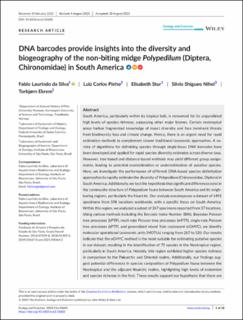| dc.description.abstract | South America, particularly within its tropical belt, is renowned for its unparalleled high levels of species richness, surpassing other major biomes. Certain neotropical areas harbor fragmented knowledge of insect diversity and face imminent threats from biodiversity loss and climate change. Hence, there is an urgent need for rapid estimation methods to complement slower traditional taxonomic approaches. A variety of algorithms for delimiting species through single-locus DNA barcodes have been developed and applied for rapid species diversity estimates across diverse taxa. However, tree-based and distance-based methods may yield different group assignments, leading to potential overestimation or underestimation of putative species. Here, we investigate the performance of different DNA-based species delimitation approaches to rapidly estimate the diversity of Polypedilum (Chironomidae, Diptera) in South America. Additionally, we test the hypothesis that significant differences exist in the community structure of Polypedilum fauna between South America and its neighboring regions, particularly the Nearctic. Our analysis encompasses a dataset of 1492 specimens from 598 locations worldwide, with a specific focus on South America. Within this region, we analyzed a subset of 247 specimens reported from 37 locations. Using various methods including the Barcode Index Number (BIN), Bayesian Poisson tree processes (bPTP), multi-rate Poisson tree processes (mPTP), single-rate Poisson tree processes (sPTP), and generalized mixed Yule coalescent (sGMYC), we identify molecular operational taxonomic units (MOTUs) ranging from 267 to 520. Our results indicate that the sGMYC method is the most suitable for estimating putative species in our dataset, resulting in the identification of 75 species in the Neotropical region, particularly in South America. Notably, this region exhibited higher species richness in comparison to the Palearctic and Oriental realms. Additionally, our findings suggest potential differences in species composition of Polypedilum fauna between the Neotropical and the adjacent Nearctic realms, highlighting high levels of endemism and species richness in the first. These results support our hypothesis that there are substantial differences exist in species composition between the Polypedilum fauna in South America and the neighboring regions. | en_US |

